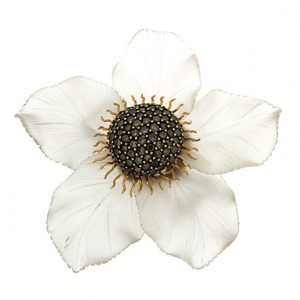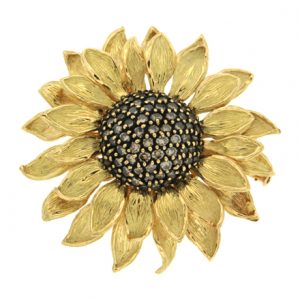When most people picture diamonds, they imagine transparent colorless jewels. Diamonds in their purest state have no discernable hue. Most however contain traces of nitrogen, which may add subtle coloring to the crystal. The majority of diamonds fall under the D-Z range of color, or from completely clear to modest tints which may be disguised with careful mounting.
Fancy color diamonds exist outside the D-Z scale. They’re quite rare, with one found out of every 10,000 diamonds mined. Of these, some hues are more widely available than others. Yellow and brown are common colors, while few red diamonds exist.
How Diamonds Become Fancy
 Just as diamond color can vary, there are diverse ways diamonds gain their hues. These include trace elements, radiation, inclusions and plastic deformation. Some methods are unique to certain colors, while other hues, such as orange or purple, are achieved through multiple characteristics in the same gem.
Just as diamond color can vary, there are diverse ways diamonds gain their hues. These include trace elements, radiation, inclusions and plastic deformation. Some methods are unique to certain colors, while other hues, such as orange or purple, are achieved through multiple characteristics in the same gem.
Diamonds are made of carbon. If a few atoms of another element, known as trace elements, replaces bits of carbon in the crystal, the jewel may reflect color. When a diamond is exposed to certain types of radiation, some atoms may be displaced, forming color centers in the stone.
Natural diamonds don’t form in a vacuum. As they take shape, they may trap other minerals inside their crystal. The volatile environment that creates diamonds may cause the stones to develop imperfections in their lattice structure. Either of these natural conditions of a diamond’s birth may cause Fancy colors.
Yellow/Brown
The most common fancy diamond colors are yellow and brown. While many diamonds have hints of these colors, few are intense enough to receive a Fancy designation. Diamonds become yellow through traces of nitrogen mixed within its crystal. While the vast majority of diamonds contain hints of nitrogen, Fancy yellow diamonds were virtually unknown until South Africa’s diamond boom in the 1860s.
Brown diamonds may get their hues in multiple ways. Trace elements are one way, though radiation is more common. Brown diamonds regularly occur in diamond mines, though until the 1980s, there was little demand for the jewels. Around this time, Australia’s Argyle mine started to produce large amounts of brown diamonds. This lead to heavy advertisement conveying the beauty of these gemstones, using luxurious terms such as “cognac” and “chocolate.” Designers took notice, and incorporated them into their jewelry.
Black/White
In Renaissance era paintings, diamonds appear black. This is not due to fancy colors, but from limitations in technology which downplayed brilliance. Fancy black diamonds achieve their color through clarity characteristics. Depending on the jewel, there may be dark fractures inside the stone which tint the entire jewel, or the cracks may have partially converted to graphite. In other instances, minerals such as graphite, iron or hematite within the diamond are the causes of color.
Blue
Blue hues occur in less than one percent of all diamonds. To achieve this color, a diamond must have no hints of nitrogen in its crystal, while containing traces of boron. While other diamonds have bluish hues without boron, these colors are mixed. Green-blue comes about through radiation, while grey-blue is derived from trace hydrogen.
Green
Diamonds turn green when exposed to certain kinds of radiation. While this color is achieved in a laboratory setting, naturally occurring green diamonds have been mined for centuries prior. Such stones often have uneven hues, though exceptions like the Dresden Green diamond exist. Gemology experiments in 1904 involved burying diamonds with radium salts. While the stones turned green, they were too toxic to handle. Today, irradiated gemstones are tested for safety before they’re released to the market.
Pink/Red
Pink and red diamonds get their colors from the same source. Rather than trace minerals, radiation or inclusions, deformations in the stone’s lattice causes the jewel to reflect reddish light. In most cases, the quirks in the gem are mild, turning the diamond pink. Pink diamonds are both uncommon and in high demand, fetching record breaking prices at auctions. One such jewel, the Sweet Josephine, was sold at Christie’s for over 1.7 million dollars a carat.
Red diamonds are extremely rare. One leading gemological laboratory spent thirty years evaluating jewels without encountering a red diamond. Of those that exist, only three measure over five carats. Each of these stones are unusual enough to receive names, the 5.03 carat DeYoung Red, the 5.05 Kazanjian Red Diamond, and the 5.11 Moussaieff Red.
Fancy Color Grades
Unlike the D-Z rating scale for most diamonds, Fancy diamonds have a more descriptive rating system.
As diamond colors vary in terms of tone and saturation, their grades reflect this diversity. These designations include Fancy Light, Fancy, Fancy Deep, Fancy Vivid, Fancy Intense, and Fancy Dark. While stones with medium to medium dark tone and strong saturation leave a strong impression color wise, all Fancy diamonds are unusual enough to draw interest.
Cut and Color
 When fashioning Fancy diamonds, cutters must keep many factors in mind. As with D-Z diamonds, the larger the jewel, the less common they are. Preserving carat weight may add value to the diamond. Stones that are unusually deep can allow for light to travel through more of the crystal, highlighting the color of the jewel.
When fashioning Fancy diamonds, cutters must keep many factors in mind. As with D-Z diamonds, the larger the jewel, the less common they are. Preserving carat weight may add value to the diamond. Stones that are unusually deep can allow for light to travel through more of the crystal, highlighting the color of the jewel.
Certain cuts, such as the radiant, are capable of intensifying color while retaining carat weight. Stones that are low on the D-Z scale, with a visible tinge, may be cut so they’re transformed into Fancy diamonds. Some jewelers may even take an already cut D-Z diamond and refashion it into a Fancy jewel, sacrificing carat for greater color and appeal.





